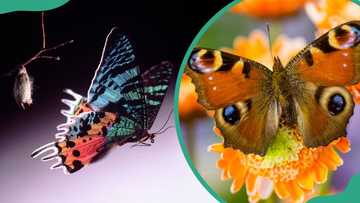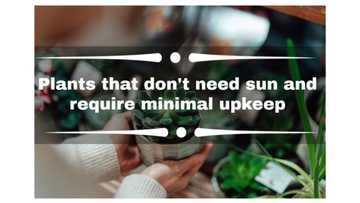55 fascinating facts about sunflowers to make your day brighter
Sunflowers were first grown in North America, but today, they are cultivated in almost every part of the world. The plant was first considered a food crop for humans and animals, but nowadays, its numerous other uses have been discovered, making it a valuable crop. There are so many acts about sunflowers that will not only surprise you but increase your knowledge of the plant.

Source: UGC
Sunflowers are one of the most beautiful plants on the earth. Despite their attractive appearance, not many people understand the plant because of its many misconceptions. The following facts about sunflowers will help you understand the plant beyond its beautiful appearance.
Sunflower facts for kids
Sunflowers are one of many plants that kids love due to their bright colours. However, curious kids will not be satisfied with the colour alone. They will want to know more about the plant.

Source: UGC
- Sunflowers were first planted in North and Central America.
- The total quantity of sunflower production worldwide is estimated to be 57 million tonnes.
- Sunflowers have different colours. Even though yellow ones are the majority, red and purple sunflowers exist.
- Vincent Van Gogh, a Dutch painter, was known for sunflower artwork. However, he was not the only painter who specialized in sunflowers. Other known artists are Diego Rivera, Alfred Gockel, and Paul Gauguin.
- The average height of a sunflower is 5 feet. However, the heights of the plants are different depending on the variety. There are dwarf and tall sunflower varieties.
- Ukraine is the leading sunflower producer, with about 14 million tonnes, followed by Russia with 12 million tonnes.
- The tallest sunflower in the world was grown by a German farmer Hans-Peter Schiffer, and it was 30 feet 1 inch (900 centimetres) tall.
- Young sunflowers are heliotropic, meaning they tilt depending on the sun's position. They face east in the morning and west in the evening.
- A sunflower is made up of smaller flowers on its head.
- There are two types of sunflower seeds, black and white seeds. The black seed is rich in oil and used for manufacturing, while the white seed is for snacks and animal feed.
- For maximum yield, a sunflower requires at least six hours of sunlight. However, the more the sun hours, the better its production.
- The name of the plant has a Greek meaning. In Greek, Sun is helio, and flower is anthos.
- It is estimated that a sunflower can produce two thousand seeds.
- There are about 70 species of sunflowers. Each species thrives in a particular region, depending on the climate.
Fun fact about sunflowers
Sunflowers are interesting plants, from how people perceive them to their behaviour. Besides, there is more to learn from the plants than meets the eye. These fun facts will surprise you.

Source: UGC
- Sunflower is one of the few plants used to make butter. Sunbutter is made from the plant's seeds and has less saturated fat than other types of butter.
- A sunflower has male and female parts, making it possible for self-pollination. Its stigma can bend to reach its pollen.
- There is a yearly sunflower carnival held in Cologne, Germany. The event is attended by locals and tourists who don sunflower costumes.
- On a cloudy day, young sunflowers face each other because they cannot track the sun.
- Once a sunflower plant matures, it faces east and does not track the sun like the young plants.
- The dwarf variety of sunflowers can be grown indoors. The dwarf variety attains a height of 3 feet (91 centimetres) at maturity.
- The plants are used for decorations and may last up to 12 days before withering. A properly hydrated plant can last even longer.
- They belong to the daisy family or Asteraceae, which has the most flowering plants, such as lettuce and chrysanthemums.
- Sunflower is the only flowering plant with the word flower in its name.
- It is Ukraine’s national flower and an important plant in Ukrainian culture. They are used for wreaths, wall paintings, and furniture carving.
- Halva dessert is prepared using sunflower and has gained popularity in other parts besides Ukraine.
- Most sunflower varieties are annual plants, meaning they are harvested once and replanted. The plant takes about three months to mature.
- A sunflower farm based in Canada was closed due to the high number of people visiting the farm.
Scientific facts about sunflowers
Many discoveries about sunflowers have been made, and researchers continue to reveal other amazing things about the plant. Below are some science-related facts you probably did not know.

Source: UGC
- Linoleic acid in sunflowers is converted to arachidonic acid, which prevents inflammation.
- Oil extracted from sunflowers is rich in polyunsaturated fats, which are associated with reducing cholesterol. It is good for the heart.
- Some people are afraid of sunflowers, and this fear is called Helianthophobia.
- Sunflower oil is a rich source of vitamin D.
- The plants symbolize positivity and have inspired many people for a long time. They represent loyalty, longevity, joy and life.
- Even though the plant’s flower is lovely, it has a rough side. Its leaves are dull green, rough and spiky.
- Kansas State in the US is also known as Sunflower State. It is native to the common sunflower species Helianthus annuus.
- Sunflower is one of the few plants that can reportedly absorb radiation energy. It was planted around areas that were affected by Chornobyl and Fukushima accidents.
- For every 100 pounds of oil, seeds can produce up to 40 pounds of oil. Therefore, the oil content in the seeds is 40%.
- Closely planted sunflowers will not yield the best because they compete for the few available nutrients.
- Sunflower seeds are edible and are used for making snacks for humans and food for animals.
- The plant has medicinal value. In North America, communities use it to cure skin ailments and make skincare products.
- In 2012, astronaut Don Pettit took sunflower seeds to the International Space Station. He planted the seeds in space.
- Sunflower seeds are rich in minerals and vitamins such as zinc and selenium, which can boost your immunity.
Random sunflower trivia and answers that will surprise
How much do you know about sunflowers? These random interesting facts about the plant will surprise you while enhancing your knowledge of the plant.

Source: UGC
- Which country was the first to export sunflowers? Spain was the first country to export the plant in 1500.
- Are sunflowers toxic to dogs? The plant is not toxic to dogs because it is used to make animal feed, including dog snacks.
- Can you eat sunflowers? The seeds of the plant are used to make various delicacies. For instance, Halva is a sunflower delicacy in Ukraine.
- Are sunflowers toxic to cats? Like dogs, cats can eat the plant but may experience mild stomach upsets.
- How many petals does a sunflower have? The plants have numerous petals, also known as ray flowers. The petals may be in single or double rows.
- What does it mean to be called a sunflower? It holds multiple meanings, including honesty, optimism, peace, admiration, and devotion.
- Do sunflowers regrow? Annual and perennial varieties exist. Perennial varieties regrow in the following year, but annual varieties are replanted.
- Can sunflowers be used for medicine? They have medicinal value and have been used as a remedy for pulmonary infections and making cough syrups.
- What do you call a person who loves sunflowers? People who love the plant are called anthophile.
- Do sunflowers require insects for pollination? The plants can self-pollinate.
- How long does it take to harvest sunflowers? Depending on the variety, it requires between 80 days to 140 days to harvest it.
- Can you grow sunflowers indoors? It is possible to plant the dwarf variety indoors because its height is 3 feet (91 centimetres).
- Is sunflower a biofuel? Due to its high oil content of about 40%, it is a good choice for biofuel.
- How much sunflower does it take to make 1 litre of oil? Approximately 1.4 kilograms of seeds will produce a litre of oil.
Besides their vibrant and aesthetic appeal, the plant has multiple uses discovered over time. Facts about sunflowers, including their history and meanings, are a great addition to what you already know, and you can share them with your friends who love the plant.
READ ALSO: 63 deep self-growth quotes to aid you in personal development
Legit.ng recently published an article about self-growth quotes. A personal development journey requires dedication, and you must be honest with yourself to achieve the goal. Even though it is a challenge, quotes about personal development can keep you on track and not give up.
Most self-development happens in mind. Therefore, having a positive mentality is a prerequisite as you strive to achieve your goals. The self-development quotes will motivate you and give you a kick-start in your journey to rediscovering yourself.
Source: Legit.ng






